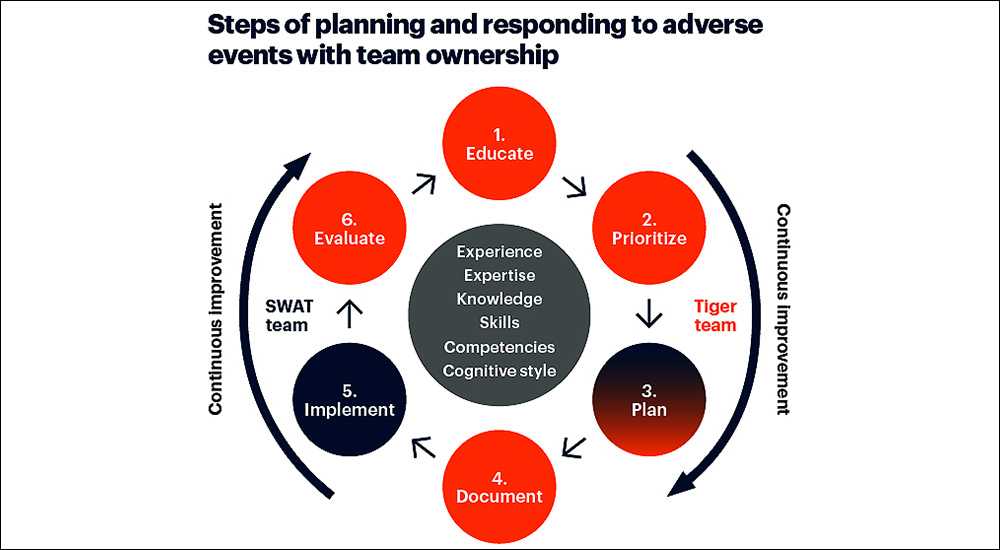Why managing the pandemic needs two crack teams, Tiger and SWAT

When an oxygen tank exploded during the Apollo 13 mission to land on the moon, NASA quickly formed what it later called a Tiger team — a small group of specialists with different areas of expertise to investigate the issue and figure out how to get the four astronauts home. Their work guided the actions of the flight crew to turn a major crisis into a shining moment in the history of the US space programme.
Tiger teams fulfill a crucial risk management function, but they are not enough to fully protect organisations from experiencing negative financial, operational or reputational outcomes due to adverse events, such as a natural disaster, major security hack or global pandemic.
That is because the skills needed to predict and educate about adverse events are different from the skills needed in a moment of crisis. Data ethics dilemmas like these are becoming more urgent as business leaders look to data and analytics programs to produce business value.
Anticipating adverse events is a qualitatively different task than responding to adverse impacts when they occur. Many organisations use the same individuals in both scenarios, but not all team members are best suited for both situations.
Instead of one team to fulfill all aspects of adverse event prediction and response, there should be two: A Tiger team to anticipate and educate, and a SWAT team — derived from the special weapons and tactics units from military and police forces — to handle on-the-ground actions in crisis situations.

Different teams lead during different phases. For example, Tiger teams lead the process of identifying possible adverse events and educating the organisation, prioritising which events to plan for and documenting the response. SWAT teams, for their part, lead the event response.
The two teams collaborate on planning. The Tiger team takes a first pass to identify procedures, and the SWAT team assesses their feasibility and recommends adjustments. And both team’s particulate in evaluating the results after the fact and looking for ways to improve.
Both Tiger and SWAT teams need people with concrete skills and competencies. Less concrete are the various ways of thinking — also known as cognitive styles — that are critical to meeting the needs of a Tiger or a SWAT team.
For example, people who tend to wait until they have all the relevant information before making a decision are well-suited to the methodical, research-driven work of a Tiger team. People who are willing to act on limited knowledge, on the other hand, are essential SWAT team members. The former has a low tolerance for ambiguity; the latter, high.
Leaders can assess five cognitive dimensions in their Tiger and SWAT team candidates to determine their cognitive style and create balanced teams. For each dimension, a person’s style falls on a continuum between two poles. The dimensions and their poles are:
Problem solving, Better vs different
Does the person approach problems by looking to improve on what exists better, or by reframing the problem altogether different?
Perspective, Part vs whole
Does the person break an issue down into component parts and examine each one independently part perspective, also known as analytical perspective? Or does the person view events in terms of the entire system of which they are part and draw intuitive connections and associations whole perspective, also known as intuitive perspective?
Tolerance for ambiguity, High vs low
Does the person gather as much information as they can before drawing conclusions low tolerance, or are they willing to make a faster call based on partial insight high tolerance?
Focus, People vs task
Does the person thrive on collaborating with others people focused, or on completing work and seeing results task focused?
Focus, Internal vs external
Does the person think through solutions alone and then present them to others for feedback internal, or does the person seek out group brainstorming and interaction to articulate and hone ideas external?
As with tolerance for ambiguity, the work of Tiger and SWAT teams in many cases aligns with certain cognitive styles. People who automatically question and reframe problems are excellent Tiger team members, skilled at identifying possible adverse events. The middle of a crisis is not the time to completely rethink a plan, however, so improvers make better SWAT members.
Yet staffing teams is not a binary exercise of placing people with one style on the Tiger team and another on the SWAT team. The most effective teams have a balance of cognitive styles, says Struckman.
Key takeaways
- The skills needed to predict about adverse events are different from the skills needed in a moment of crisis.
- The Tiger team takes a first pass to identify procedures, and the SWAT team assesses feasibility and recommends adjustments
- Anticipating adverse events is a different task than responding to adverse impacts.
- Organisations use the same individuals in both scenarios, but not all team members are suited for both situations.
By Christie Struckman, Vice President Analyst, Gartner.





